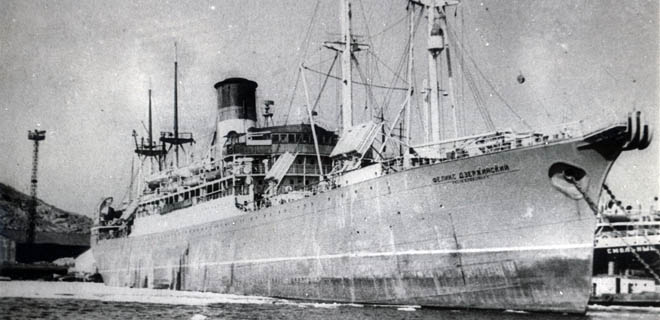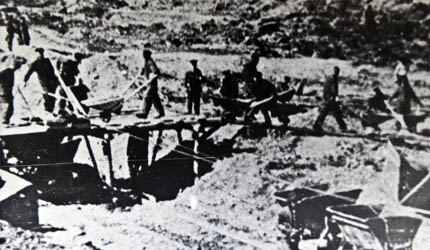|
Second World War
|

During the period before the war, Magadan was more “civilized”. The original headquarters of timber were replaced by a large new brick building. The small club for NKVD officials was transformed into a real theatre. Camps in the region were improved and many of today’s villages consist of building from that period (which slowly came to an end in the years 1953-57).
It cannot be said that conditions reached the same levels as under Berzin. Fatalities were high throughout Dalstroi’s history but the occasional instance of terror was more the exception than the rule.

When the Soviet Union was forced into the war in 1941 just a few months after negotiating with Nazi Germany how the British Empire was to be divided between them, the supply of prisoners to Kolyma was interrupted. Supplies were also interrupted and profits for the collective farms in Kolyma were modest. Prisoners died in considerable numbers during the first winter of the war 1941/42 and Molotov even had to insist they should be treated better. Not on humane ground but simply to ensure productivity. Why Molotov who was the foreign minister should intervene is not clear but I do have a copy of his order.
Gold production fell to a somewhat lower level that before. It stabilised at around 60 tons of pure gold per year.
For the prisoners, in accordance with a decree from Stalin, the war meant that no one was to be released until the war was over. There was in fact one prisoner, Vladimir Petrov, who was lucky as he was able to tell how he was set free the day before the outbreak of war. He managed by hook or by crook to avoid being sent back to the camps.
The Lend-Lease arrangements
The Lend-Lease agreement between the United States and Great Britain was rapidly extended to include the Soviet Union. According to Churchill's memoires, it was some time before deliveries materialised from the States. No one knows when the first supplies arrived in Kolyma but as the war advanced, American provisions represented a considerable proportion of the supplies sent to the region. For the prisoners, it meant the arrival of white bread which they continued to talk about years after the war was over.
In one of his short stories, Varlan Shalamov recounts that the first Catapillar bulldozers to arrive were used to dig mass graves in the permafrost. Others have told me the same story but it might well be based on Shalamov's account. It is also said that the hungry prisoners ate the lubricating grease for the bulldozers and I have spoken to a prisoner who said he had eaten some himself.
Another wonder to arrive in Kolyma was a mechanical gold excavator. It was a huge piece of equipment, almost a transportable factory, and it was delivered in wooden crates. A prisoner who was not only an engineer but could understand English was put in charge of an assembly team. The machinery was put it together successfully and is, in fact, still in operation today. One of the locals told me in 2007 that it was No. 170. It was not the number you might expect but a high number was used to indicate to the Americans that lots of similar machines were already in use. Later, copies of the excavator were made. When operations were at their peak, over 50 were in operation around Susuman. Today (November 2007) there are still eight left in service, including the one originally delivered from America.

In 1944, Henry Wallace, the US vice-president, arrived on a visit. His mission was apparently to check the use of Lend-Lease deliveries in the Russian Far East and Asia (specifically Mongolia and China). However, in the book he wrote about the trip, he explains it was more a matter of improving relations with the Soviet Union which, at the time, was suffering under the strain of war.
Huge preparations had been made for Wallace's trip. His plane, a Douglas C54 Skymaster, was too big for many of the airports but they were extended specially for his visit. His hosts explained: ”We were going to do it anyway. We are developing large planes ourselves.” The barbed wire was removed from the camps Wallace passed on his route (by air) and the prisoners were kept far from the towns where he landed. In Magadan itself, the prisoners were kept inside cultural centres and assembly halls where they were shown films non-stop until Wallace had moved on.
Wallace, who had been a farmer before he became vice-president, wanted to see Kolyma's collective farming. Rumour has it that it was the children of NKVD officials who were sent out to act as farmers. According to one of the stories, Wallace asked how the pigs were cared for on one of the farms. The pig farmer is reported to have come up with a quite ridiculous answer but the interpreter saved the day by saying something that made sense to a farmer. The only problem is that, if we are to believe his book, Wallace understood Russian.
Wallace wrote enthusiastically about everything he saw. In his book, he maintained that the United States had much to learn from people like Nikishov, despite the reports Churchill apparently sent to the Americans about Stalin's camps, Kolyma included. Churchill had his facts from the Poles Stalin had released from the camps and allowed to travel to Great Britain. Perhaps Wallace knew no better. But at least it could have been explained that he tried not to know any better. It branded his story for ever. Wallace was big enough to apologise for his book and to withdraw it from the market. It is very difficult to obtain a copy today. Fortunately, the author of this article managed to do so.
Next: The last GULAG years
